You might have heard of whirlybirds or whirlygigs while in elementary school. Most teachers use these types of seeds to catalyze the development of inquiry skills among learners during a science lesson.
Helicopter seeds are flying seeds that whirl to the ground in a beautiful spectacle. Besides that, they can travel for a long distance after falling from a tree. These papery winged seeds are edible and can make incredible toys for kids.
In this article, we’ll discuss more on samara fruit, helicopter seeds, and how they spread. We will also give you insight into different types of trees with helicopter seeds. Let us now find that out together:
What Is a Samara Fruit?
A samara is a type of fruit with a flattened fibrous wing and papery tissue that develops from the ovary wall. The fruit falls from a tree after ripening, and the papery tissues spin like helicopter blades when blown by the wind.
Samara fruits are native to North America, South America, Europe, Asia, and Africa. These fruits are used in pies, jams, and jellies. Samara fruits can also be eaten raw or make juices and smoothies.
Most tree species that produce samara fruits are beautiful. They have long and narrow leaves with deep brown bark color. These samara trees are also large and can grow up to 30 feet with minimal care requirements.
What Are Helicopter Seeds?
Helicopter seeds are seed types that have papery tissues and winged structures that spin in the wind after falling from the tree. The spinning allows the seeds to disperse further away from the parent tree and reproduce successfully.
Many people might have stumbled on these seeds since they are usually stuck on the shoe treads while walking in the park or through the forest. It is another method of dispersing the seeds apart from wind dispersal.
The helicopter seeds’ adaptation makes them vulnerable to being eaten by birds before landing on the ground. The ripe samara fruits can also be eaten by humans due to their sweet taste.
Helicopter seeds grow throughout the late spring and early summer. It would be best to note that only mature helicopter seeds are blown by the wind. Samara is the fruit that contains these helicopter seeds.
Different Types of Trees with Helicopter Seeds
The most popular tree and shrub species with helicopter seeds are maples, elm, and ashes. Let us now dive into the discussion of tree types with helicopter seeds:
Red Maple (Acer Rubrum)
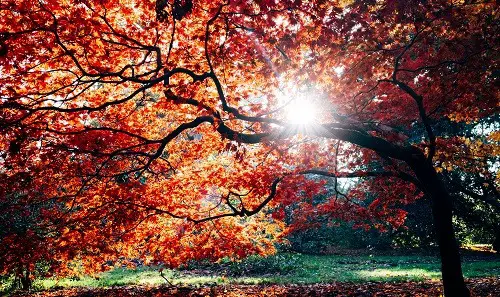
This widespread deciduous tree is also called soft maple or swamp maple. The maple species is native to eastern North America. The reddish-brown twigs, buds, and leaves are the prominent features of the red maple tree.
The red maple tree has a relatively short trunk and slender branches. The ornamental appearance makes these tree species ideal for shade or street plantation. The coloration also makes them an excellent source of nectar for bees and other pollinators.
The durable red maple wood is suitable for furniture, flooring, and paper production. Red maples thrive in the Rocky Mountains of Minnesota, Texas, and Florida. Other red maple trees can also be found in Canada (all provinces east of Alberta).
Red maples can tolerate moist or dry and well-draining soil. They also prefer bright direct or indirect sunlight to enhance proper growth. Red maples can also thrive in urban settings despite the pollution in towns and cities.
Red maples are vulnerable to tar spots, leaf spots, and verticillium wilt. Japanese beetles, aphids, and scales are the leading pests that attack red maples. The flowers develop samara fruits that produce two-winged helicopter seeds.
| Maximum Height | 40-70ft |
| Color Varieties | Red, Orange, Yellow |
| USDA Growing Zones | 3-9 |
| Sun Exposure | Full or Partial |
Silver Maple (Acer Saccharinum)
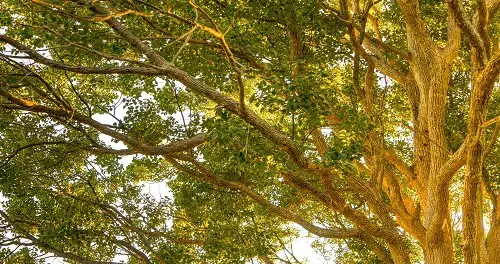
Silver maple is another maple species that hails from Eastern North America. It is a large deciduous tree that can grow up to 59-115ft tall. These silver maple trees can tolerate drought and wetlands for an extended period.
Many people prefer planting silver maple trees along the river banks or hillsides to prevent soil erosion. They produce a cluster of greenish-yellow to red flowers during the spring season. These blooms later develop into samara fruits that produce plenty of helicopter seeds.
This maple tree is becoming popular due to its showy flowers and bright fall foliages. They are the best maple trees for landscaping your backyard. Silver maple trees also produce sweet syrup for savory dishes and pastries.
| Maximum Height | 59-115ft |
| Color Varieties | Red, Yellow, Green |
| USDA Growing Zone | 3-9 |
| Sun Exposure | Full to Partial |
Harlequin Norway Maple (Acer Platanoides Drummondii)
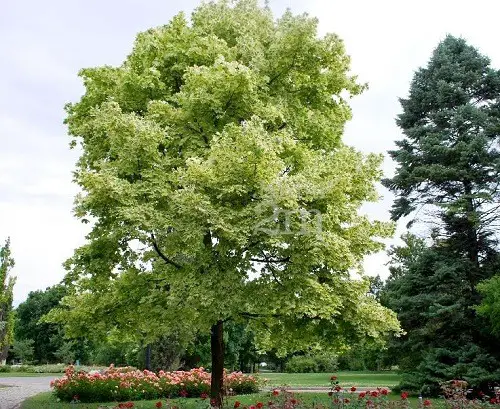
This is a hybrid cultivar of Norway and Japanese maple trees. It is a beautiful maple tree with deep green leaves and helicopter seeds that help improve the backyard landscape.
The maple tree species is tolerant to a wide range of conditions. These trees can also tolerate full or partial sunlight exposure. Besides that, harlequin maple trees are resistant to most pests and diseases.
The deep green foliages on harlequin maple trees turn yellow during the fall season. The dense canopy may provide an incredible shade though it may steal the light from the native maples. They have an average height of 60ft.
| Maximum Height | 60ft |
| USDA Growing Zones | 3-9 |
| Color Varieties | Deep Green to Yellow |
| Sun Exposure | Full or Partial |
Japanese Maple (Acer Palmatum)
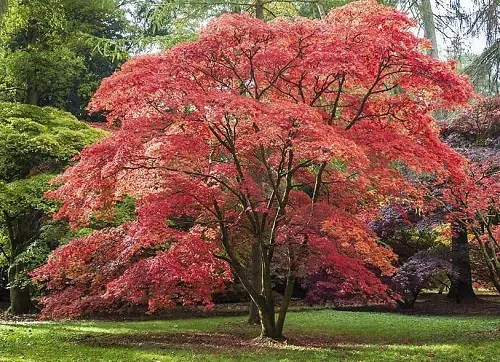
The Japanese maple tree is an excellent choice for a backyard garden for shade provision. The deep red foliages and branches’ colors are graceful and delicate. The maple tree species is native to Japan and other parts of Asia.
The Japanese maple tree is the best alternative to the Bonsai tree due to its small size and striking foliages. These maple trees are common in traditional Japanese gardens due to their medicinal and culinary purposes.
These maple trees produce small red or purple flowers that develop into samara fruits. These fruits later produce two-winged seeds that look like helicopter blades. Wind dispersal is the mode of promoting their widespread.
| Maximum Height | 15-24ft |
| Color Varieties | Red, Yellow, Orange, Purple |
| USDA Growing Zone | 5-8 |
| Sun Exposure | Bright Indirect Sunlight |
Winged Elm (Ulmus Alata)
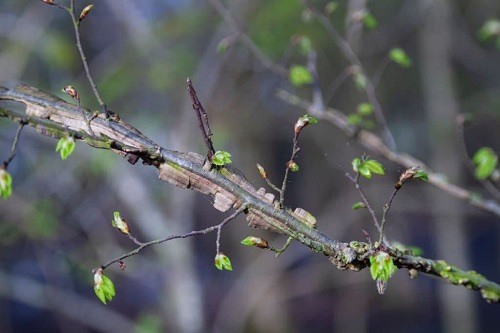
The Winged elm is a deciduous tree native to the southeastern United States. It has an average height of 50-70ft and a canopy spread of 12ft wide. The alternating simple leaves have an oblong shape with serrated margins.
The elm tree produces small inconspicuous flowers in the spring season. These flowers develop into samara fruits that ripen in late summer or early fall. Samara fruits contain two-winged seeds that whirl on the ground after falling.
The winged elm trees produce valuable woods ideal for flooring and furniture construction. The elm tree can tolerate ice and wind conditions for an extended period.
| Maximum Height | 50-70ft |
| Color Varieties | Red Flowers |
| USDA Growing Zone | 6-9 |
| Sun Exposure | Full to Partial |
Common Hoptree (Ptelea Trifoliata)
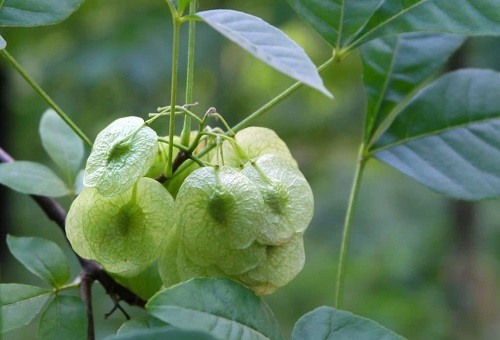
It is another popular deciduous tree native to North America. The tree has an average height range of 49-66ft with a trunk diameter of 24-35 inches. The tree has trifoliate leaves with ovate or lanceolate shape leaflets.
It also generates small greenish-white flowers with four petals in spring and summer. These flowers develop into samara fruits and later produce helicopter seeds after ripening. The tree species are tolerant to drought, poor soil, and shade.
Samara fruits from hoptree are eaten by rabbits, deer, and squirrels. The leaves can also be invaded by caterpillars during early spring. The tree has a host of benefits to humans apart from providing ornamental shade.
The bark and leaves are used to make a concoction for treating colds and flu. The fruits can also be eaten fresh or used to make savory dishes.
| Maximum Height | 49-66ft |
| Color Varieties | Greenish White Bloom |
| USDA Growing Zone | 4-9 |
| Sun Exposure | Full to Partial |
Tree of Heaven (Ailanthus Altissima)
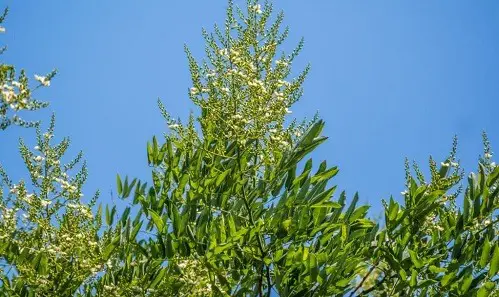
The tree of heaven is a garden ornamental and native to China. The tree was brought into the United States of America around 1784. It has become the most common urban landscape tree in North America.
These are fast-growing trees that can reach 50ft within a few years. They have large compound leaves with about 40 leaflets on each leaf. The tree also produces a cluster of small greenish white flowers at the end of its branches.
These flowers later develop into samara fruits that produce winged seeds. These helicopter seeds are dispersed by the wind away from the parent trees. Tree of heaven species is invasive and not ideal for planting together with other ornamental trees.
| Maximum Height | 50-80ft |
| Color Varieties | Greenish-white bloom |
| USDA Growing Zone | 4-8 |
| Sun Exposure | Full to Partial |
Tulip Tree (Liriodendron Tulipifera)
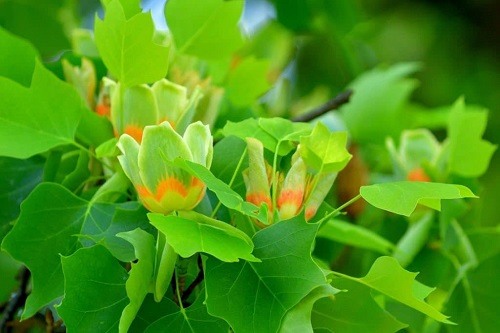
The tulip tree is native to North America and can reach about 100ft tall. These trees are fast-growing and long-living. They produce vibrant flowers during the early spring that later turn into corn-like structures containing small hard seeds.
Tulip trees are deciduous since they lose leaves in the fall season. The leaves are usually large with four lobes for easy recognition and identification. The green-yellow flowers are cup-shaped and grow in clusters at the end of the branches.
Tulip trees grow in woodlands, along the streams, and in moist locations in the eastern United States of America. They are also excellent for landscaping due to their fast-growing nature to provide ornamental shade and beautiful bloom.
| Maximum Growth | 100ft |
| Color Varieties | Yellow-green with an orange center |
| USDA Growing Zone | 4-9 |
| Sun Exposure | Full to Partial |
Tipu Tree (Tipuana Tipu)
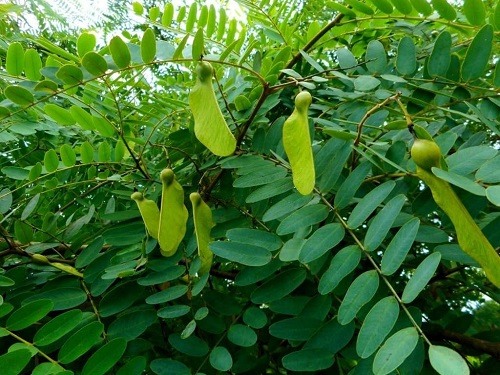
Tipu trees are native to Bolivia, Argentina, Brazil, Peru, and Uruguay. These flowering trees produce orange-yellow blooms that appear in clusters at the end of branches. These flowers later develop into long seed pods that contain numerous helicopter seeds.
The tipu tree woods are hard and dense for making furniture or flooring. Some native South Americans use the tree to construct houses and other buildings. Birds, monkeys, and bats love living on tip trees.
Deers usually browse the tipu tree leaves, and rodents eat the small seeds. Bees and other insects love hovering around the flowers for nectar and facilitating pollination. The versatility of tipu trees help maintain forest biodiversity.
| Maximum Height | 50ft |
| USDA Growing Zone | 9-11 |
| Color Varieties | Yellow Bloom |
| Sun Exposure | Full to Partial |
Green Ash (Fraxinum Pennsylvanica)
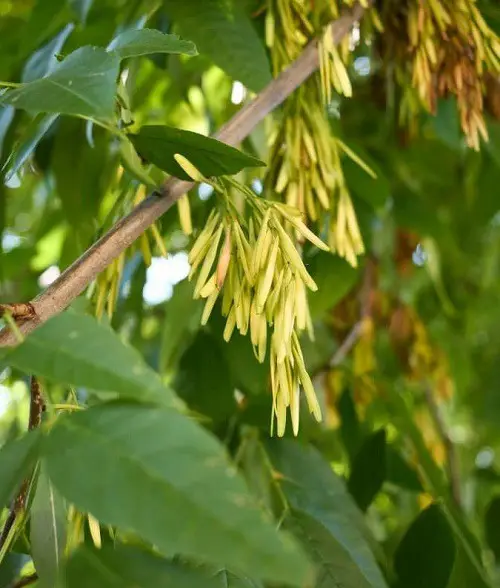
Green ash is a unique ash variety hailing from North America. The tree species thrive well along the river banks and streams to produce ash-green leaves throughout its growing season before turning yellow or brown in fall.
The pinnate compound leaf has several leaflets growing in opposite patterns. The small leaflets are attached to the central stalk. The trees usually bloom in early spring and summer that later develop into helicopter seeds.
| Maximum Height | 70ft |
| USDA Growing Zone | 3-9 |
| Color Varieties | Purple Bloom |
| Sun Exposure | Full to Partial |
Velvet Ash (Fraxinus Velutina)
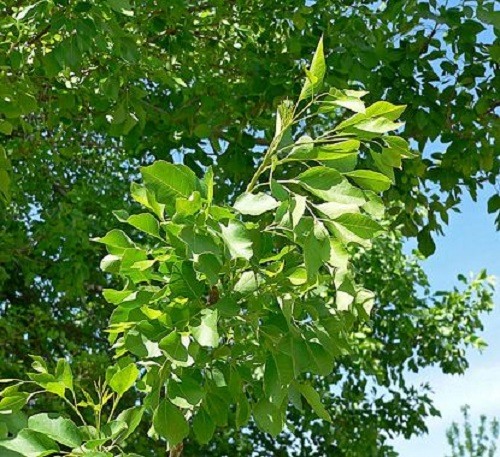
It is another fast-growing ash tree species that can reach 50ft in less than a year. The tree produces compound leaves with each leaf having 11 leaflets. The leaflets have an oblong-shaped and velvety texture.
It also produces small flowers in clusters that later develop into fruits containing winged seeds that are dispersed easily by wind. These ash trees thrive along the streams and woodlands in Southern Canada to Northern Mexico.
Velvet ash trees are native to North America. But they have also been introduced in Europe and Asia since they can tolerate different growing conditions. Besides that, many landscape enthusiasts love velvet ash trees due to their ornamental shades.
| Maximum Height | 50ft |
| USDA Growing Zone | 7-8 |
| Color Varieties | Velvety Leaves and Green Bloom |
| Sun Exposure | Full to Partial |
Norway Maple (Acer Platanoides)
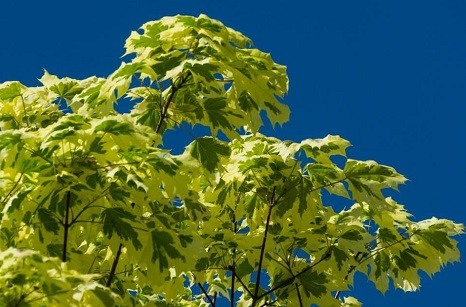
It is a large maple tree species native to Europe. The Norway maple was introduced in the United States around the 1700s and later spread across the continents. The rapid growth rate and dense foliage make these trees ideal for landscaping.
Norway maple trees are invasive and not suitable for planting together with other landscape trees in your backyard. This deciduous tree has simple and deeply lobed leaves that grow in opposite patterns.
The dark green leaves have visible veins on the lower surfaces. These leaves usually change color to yellow or brown during the fall season. The small flowers are borne in clusters and developed into two-winged samara at maturity.
| Maximum Height | 100-120ft |
| USDA Growing Zone | 3-9 |
| Color Varieties | Yellow, Green, Brown |
| Sun Exposure | Full to Partial |
Conclusion
If you have read up to this point, we can now assume that you are looking for types of trees with helicopter seeds. We hope the above list of maple, elm, and ash trees will help you make an informed decision before buying.
Helicopter seeds are fascinating since they take advantage of the wind to travel far away from the parent tree. These trees with helicopter seeds provide food and shelter for some wild animals in the forest. Feel free to share your views or suggestions in the comment section.
Readers Who Read This Also Read:
